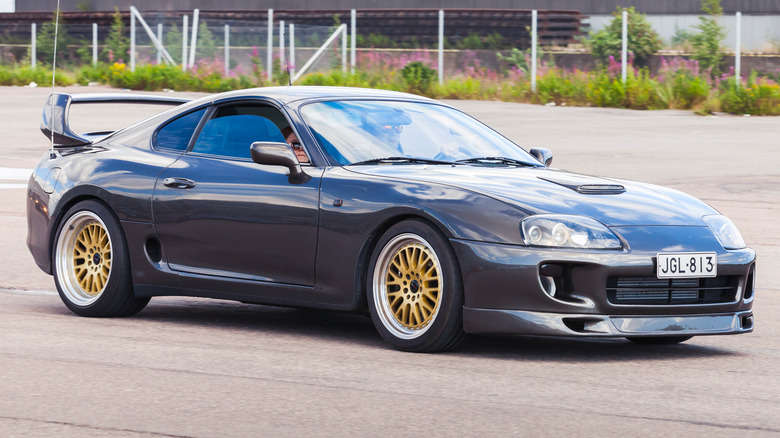
Eugenesergeev/Getty Images
Sometimes a fast car just isn’t fast enough. Whether the car in question is a practical family hauler or a highly-strung track day toy, there will nearly always be a small group of owners who simply aren’t content with its stock performance. Many of these owners have a particular goal in mind: build the ultimate street racer, or leave everyone in the rearview mirror at the drag strip. The key to a great tuner car is that it needs to accommodate every main type of owner, from those happy to fit only minor modifications to those aiming for a full overhaul.
Toyota’s rise from a small-time Japanese manufacturer to a global automotive powerhouse has been predicated on several things. Its continued development of innovative designs and technology is one part of the puzzle, but just as important to the brand’s success is its ability to cater to a wide audience. Its cars are usually affordable, reliable, and boast class-leading build quality. That makes them top choices for buyers looking for reasonably priced everyday transport, but also excellent project cars for all kinds of tuners, from professional street tuning outfits to casual weekend tinkerers. Here are the brand’s best tuner-friendly models so far.
Toyota Celica GT-Four ST205

Tokumeigakarinoaoshima/Wikimedia Commons
Originally built as a homologation requirement to allow Toyota to race in the World Rally Championship, the Celica GT-Four ST205 packs a 2.0L 3S-GTE engine and permanent all-wheel drive. It was fast from the factory, with a top speed of over 150 mph, but it’s also a great candidate for tuner builds. To cope with the demands of rallying, the engine is over-engineered and is durable enough to withstand significant power boosts.
The suspension, transmission, and clutch are also closer to competition spec than most other Toyota cars, and therefore can withstand abuse. Considering the car is now around thirty years old, that’s important, as it’s very likely that any surviving example today will have seen at least one owner who didn’t take proper care of it. Despite its shared heritage, the GT-Four doesn’t command the same price premiums as other Group A rally specials from Lancia or Ford either, meaning that it’s still within the reach of many tuners today.
[Featured image by Tokumeigakarinoaoshima via Wikimedia Commons | Cropped and scaled | CC BY-SA 4.0]
Toyota 86
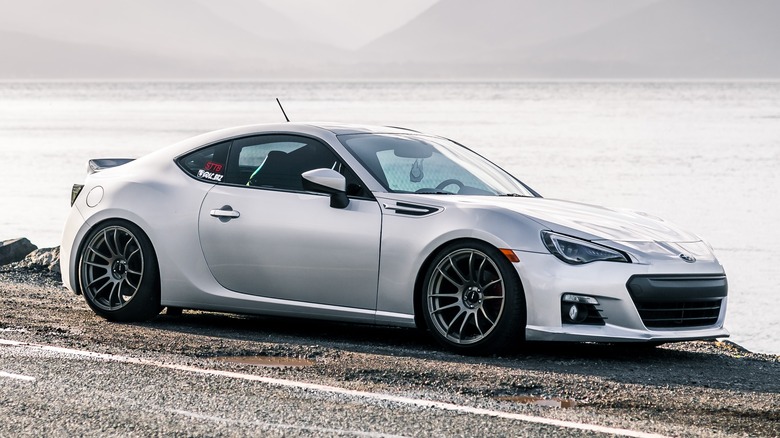
Brandon Woyshnis/Getty Images
After some years spent without an enthusiast-oriented model in its lineup, the original 86 was a return to form for Toyota. It was reasonably priced, easy to work on, and impressively reliable by sports car standards. As a result, it quickly gained a fanbase and, subsequently, a large aftermarket began to form around the car. Everything from the suspension and brakes to engine upgrades could be easily sourced off the shelf, with tuners able to choose from multiple aftermarket options based on their build aspirations and budget.
A common complaint about the 86 was its mediocre power output from the factory, although SlashGear’s 2017 review of the car found its 205 horsepower to be enough for Miata-style backroad fun. For those not satisfied with getting their thrills at road-legal speeds, however, the stock engine could handle modest power upgrades, and engine swaps were common for tuners looking for bigger numbers. In some cases, these swaps got pretty extreme – one builder even swapped in a Ferrari V8 engine for an 86 drift project.
Toyota Supra Mk4
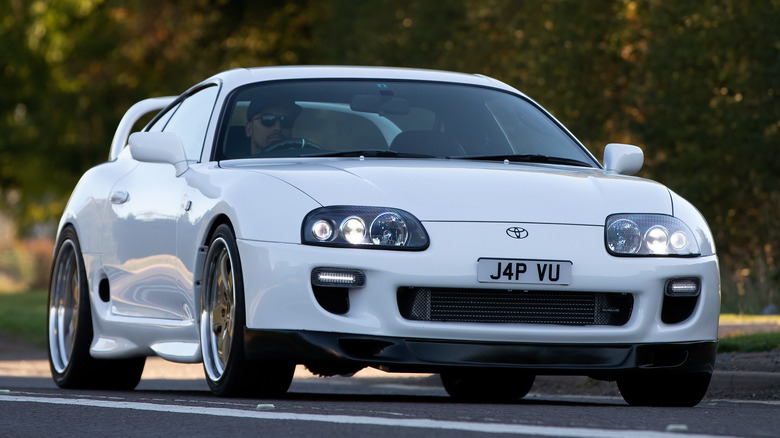
Sue Thatcher/Getty Images
When it comes to famous JDM tuner cars, there’s one Toyota model that stands out from the rest: the Mk4 Toyota Supra. With its iconic 2JZ engine under the hood, the Supra could churn out terrifying power outputs while remaining reliable enough to do the grocery run. The twin-turbo 2JZ-GTE engine was significantly over-engineered, much like its Nissan-developed rival, the RB26DETT. The latter engine could be found under the hood of the Skyline GT-R, and together with the rotary-powered Mazda RX7, the trio became globally famous for their street racing prowess.
Part of this fame can be put down to each car’s various appearances in movies, TV, and other media, with the «Fast and Furious» franchise being particularly notable for showcasing JDM tuner culture to a wider audience. However, being a street racing movie star is only one part of what makes the Mk4 Supra so cool. The Supra’s rear-drive, front-engined platform and high durability also make it a great candidate for drag car racing, and it’s made appearances in pro-spec drifting too. However, the Supra’s high resale value today means that many clean stock examples are now kept as investment pieces, significantly shrinking the inventory available to tuners.
Toyota MR2 Mk2
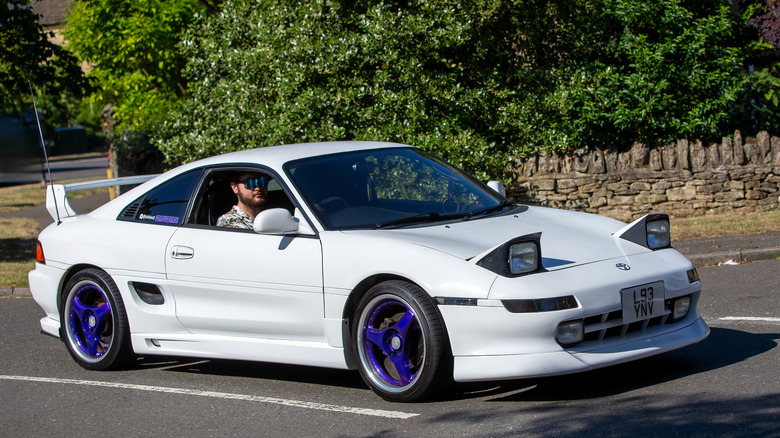
Sue Thatcher/Getty Images
The Mk2 Toyota MR2 is neither the fastest Toyota sports car, nor the most collectible. Its stock 2.0L or 2.2L engines were never going to win any awards for performance, although in turbocharged 3S-GTE form, it was decently powerful for the time. At first glance, the MR2 might not seem like an obvious candidate for a tuner’s favorite, yet it boasts a large aftermarket today and a considerable fanbase. The reason why can be deduced from its name: MR2 stands for «midship runabout two-seater.» It’s the first part that’s key — the MR2 is one of the very few affordable mid-engined cars, and it boasts stereotypical Toyota reliability.
Being mid-engined brings a host of advantages. The MR2 is inherently well-balanced in terms of weight distribution, allowing owners to add significant amounts of power without notably compromising the car’s handling. It also benefits braking performance compared to a front-engined car, allowing for better distribution of braking power between the front and rear wheels. As a bonus, it also looks cool – the MR2 shares its platform layout with many Italian exotics, which has earned it the nickname of the «poor man’s Ferrari.» The difference is that, while Ferrari takes an infamously dim view of celebrities and high-profile owners who modify its cars, Toyota has precisely zero issues with enthusiasts tuning their MR2s.
Toyota Soarer
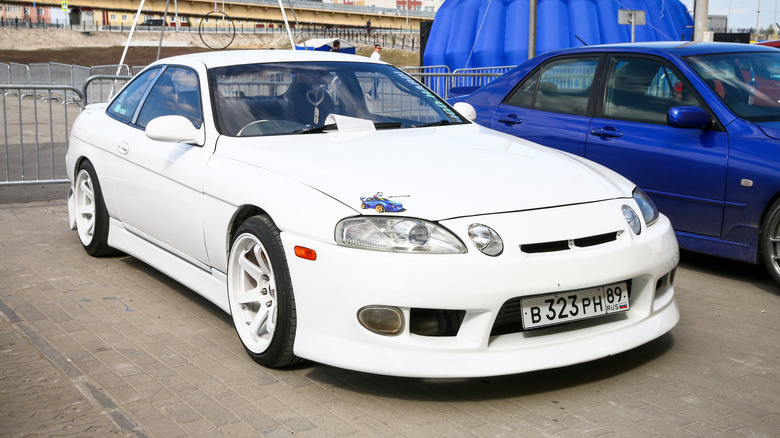
Darthart/Getty Images
When the third-generation Toyota Soarer was unveiled, Toyota had yet to launch its Lexus brand at home in Japan. As a result, all cars sold as Lexus models elsewhere in the world were sold under the Toyota marque there. In America, the Soarer was better known as the Lexus SC, a luxury coupe that could be had with a 2JZ six-cylinder or 1UZ V8 engine under the hood. In Japan, the Soarer shared the V8 and offered a turbocharged 1JZ-GTE engine as an entry-level option.
The Soarer, much like its Lexus-branded counterpart, was well-appointed inside. It featured technology that was cutting edge for its era, like a GPS and memory presets for the power-adjustable driver’s seat. However, what lay under the hood sparked the most interest from tuners. Both the turbo 1JZ and 1UZ are renowned for their durability and over-engineered nature, and both can handle large power increases versus their stock outputs. When stripped of its plush but heavy interior trim, the Soarer can be transformed from an upmarket cruiser into a tire-shredding street or drift missile.
Toyota Celica (first generation)
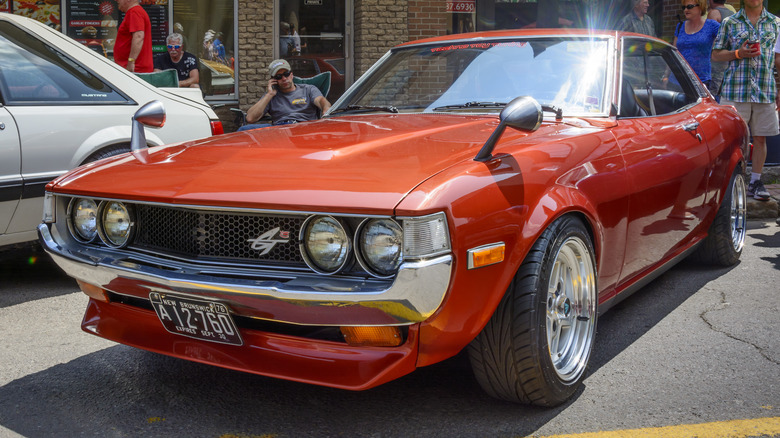
Kenmo/Getty Images
The Celica is one of Toyota’s longest-running sports car nameplates, remaining in production from 1970 to 2006. It spawned several particularly notable tuners’ favorites, including the aforementioned GT-Four and the Supra, but the first-generation Celica deserves a separate mention for first establishing the Toyota name as one to watch for tuners.
It took inspiration from leading American pony cars like the Ford Mustang and Chevrolet Camaro, borrowing styling cues from both. In sportier GT form, the similarities between pony cars and the Celica were even clearer, with the Japanese car likened by some to a shrunken muscle car. It didn’t boast muscle car performance though, and far from it — in fact, the 20R engine at the heart of the sportiest Celica GT was shared with everyday models like the Corona sedan and Toyota’s pickup line.
It might not have been powerful compared to its American counterparts, but the Celica’s shape and affordable starting price made it a big hit in Japan, being particularly popular among young drivers. Many of these drivers would add their modifications to the car, forming the basis for Japan’s emerging tuner scene. While it may never have become as globally famous as later cars like the Supra, the original Celica’s role in helping expand the appeal of tuning among Japanese drivers helped pave the way for those future icons to emerge.
Toyota Supra Mk5
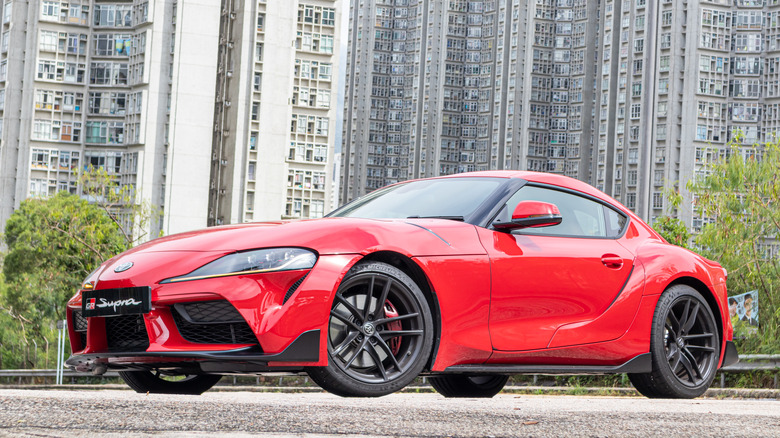
Teddyleung/Getty Images
Although the Celica is no longer in production, one of the nameplates it spawned was recently resurrected after many years of dormancy. The Mk5 Supra was the long awaited followup to the iconic Mk4, and perhaps unsurprisingly, not everyone was happy with it. Chief among the criticisms were its links to BMW — whereas the Mk4 was an all-Japanese affair, the new Supra was developed in conjunction with the German manufacturer and shared many parts with the Z4.
We found ourselves won over by the Supra’s charms when we reviewed the 3.0L variant in 2023. It might feature BMW bits underneath, but we thought the resulting car still managed to feel distinctly like a Toyota. It handles well, is reasonably priced considering what else is on the market, and like any other top Toyota tuner car, it boasts a solid aftermarket. Big names like HKS wasted no time in unveiling a suite of upgrades for the car almost as soon as it came out, pushing its power output north of 400 horsepower with only minimal modifications. More thorough tuning overhauls have the potential to produce much higher power figures too.
Toyota Corolla AE86
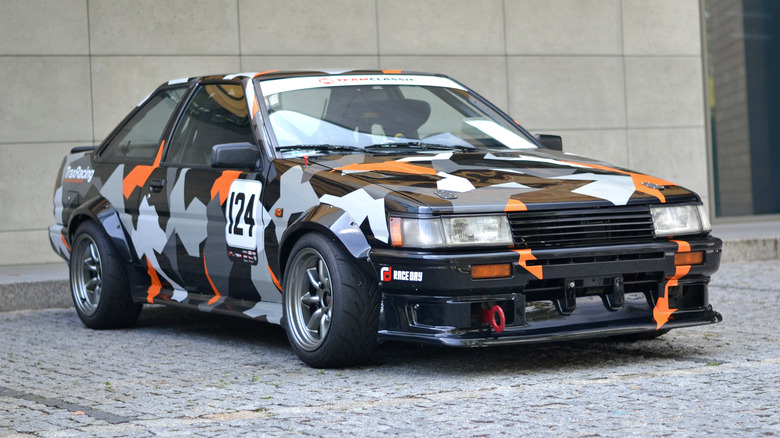
Tramino/Getty Images
The stock Toyota Corolla AE86 wasn’t all that exciting. At least, not at first glance — with a modest power output, a practical hatchback shape, and an affordable starting price, it wasn’t exactly a halo car from the factory. However, thanks to the talents of Keiichi Tsuchiya, also known as the «Drift King,» the AE86 became famous in Japan for its ability to go sideways. Tsuchiya’s exploits were later immortalized in «Initial D,» introducing the AE86 to a wider audience and enshrining it as a JDM classic.
The Toyota 4A-GE under the hood of the AE86 is considered one of the most reliable Toyota engines ever built, making it a solid base for upgrades. However, it’s common to find cars with engine swaps to give the little Toyota the tire-smoking power to back up its reputation. There’s no one best engine for an AE86 engine swap, and owners have swapped in everything from a Toyota 3S-GE to an LS V8. With so many options and so much existing information available online from past and present owners, there are very few tuner projects out of the question for the most determined (and deep-pocketed) AE86 owners.
Toyota GR86
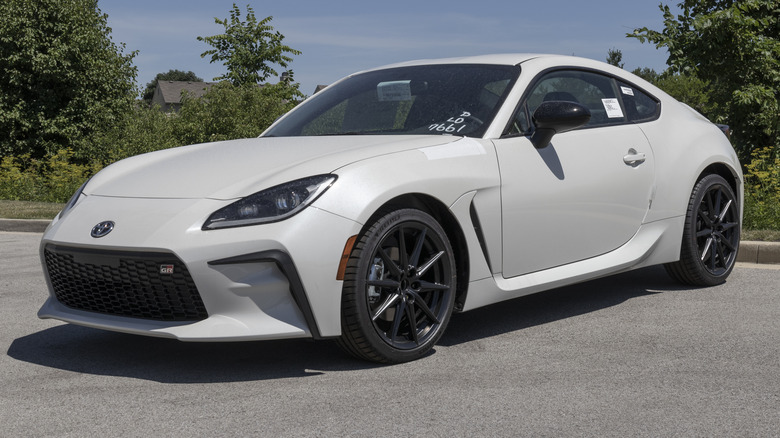
Jetcityimage/Getty Images
Toyota’s second-generation 86 sports car gained two letters in its name and an extra power bump, but it’s not too radical of a departure from the outgoing car. SlashGear reviewed the GR86 at launch and found it to be an improvement nonetheless. It’s still affordable and sits alongside the Miata as one of the cheapest new sports cars on the market. It’s still supported by a large aftermarket, giving tuners plenty of opportunity to give the little sports car some extra grunt.
Leading suppliers boast a long list of performance upgrades in their catalogs, so whether it’s the stock suspension or the modest power output that’s up for replacement, plenty of off-the-shelf upgrades are available. As well as being a favorite with project car owners, the GR86 has also established itself as a firm favorite in a wide range of motorsport disciplines, from professional drifting to the single-make GR Cup circuit racing series.
Toyota Corolla E210
The current generation Corolla might seem like an unlikely pick but it’s arguably much more suited to tuning than many people would give it credit for. A number of tuned Corolla projects appeared at SEMA in 2018, the year the current generation was unveiled. One project was even developed in collaboration with industry heavyweights Hoonigan. The Corolla has plenty of potential for grassroots tuning work, both in standard and top-spec GR form.
SlashGear found the 2023 Corolla XSE one of the more entertaining hatchbacks on the market, even if its stock 169 horsepower four-cylinder was far from remarkable. Nonetheless, the long list of off-the-shelf aftermarket components available ensures that owners wanting to spice up their ride aren’t short on options. While a Corolla of any sort (even the GR variety) isn’t going to deliver the tuning potential of a Supra, the latter car costs enough to put it out of reach of most people. The Corolla, in comparison, is accessible to anyone who wants to enter the world of project car ownership and provides a great starter platform for tuning first-timers.